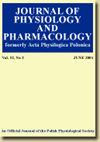Adropin as a potential protective factor of metabolic complications in obese pregnant women with hyperglycaemia diagnosed in early pregnancy.
IF 2
4区 医学
Q3 PHYSIOLOGY
引用次数: 0
Abstract
Adropin is a hormone which increases insulin sensitivity. It enhances the oxygenation of glucose in the muscles. The 91 obese pregnant women (BMI >30 kg/m2) with gestational diabetes mellitus (GDM) diagnosed in the first half of pregnancy has been recruited to the study group. The control group consisted of 10 age matched and homogeneous pregnant women with BMI <25 kg/m2. Blood samples were collected on visit V1 - between the 28th and 32nd week and on visit V2 - between the 37th and 39th week of gestation. The ELISA test was used to measure the adropin level. The results in the study group and the control group were compared. Blood samples were collected at the same visits. The median concentration of adropin was 442.2 pg/ml on V1 and 453.1 pg/ml on V2. The increase was significant (p<0.05). Results were significantly lower in the control group's patients, i.e. 57.0 pg/ml (p<0.001) on V1 and 107.9 pg/ml on V2 (p<0.001). The higher adropin level on the V1 and V2 visits were related to patients' lower BMI and better metabolic control. The increase in the adropin level in the third trimester may have been involved in the weight gain reduction, whereas better dietary adherence might have had a compensatory effect on increasing insulin resistance. However, the small control group is a limitation of this study.Adropin作为妊娠早期诊断为高血糖的肥胖孕妇代谢并发症的潜在保护因素。
促肾上腺素是一种增加胰岛素敏感性的激素。它能增强肌肉中葡萄糖的氧合作用。将91例妊娠前半期诊断为妊娠期糖尿病(GDM)的肥胖孕妇(BMI >30 kg/m2)纳入研究组。对照组为10例体重指数<25 kg/m2的同龄同质孕妇。在妊娠第28周至第32周和第37周至第39周分别进行第1次和第2次采血。ELISA法检测adropin水平。将研究组与对照组的结果进行比较。在同样的访问中采集了血液样本。adropin在V1和V2上的中位浓度分别为442.2 pg/ml和453.1 pg/ml。差异有统计学意义(p<0.05)。对照组患者的结果明显较低,V1为57.0 pg/ml (p<0.001), V2为107.9 pg/ml (p<0.001)。V1和V2就诊时较高的adropin水平与患者较低的BMI和较好的代谢控制有关。妊娠晚期adropin水平的增加可能与体重增加的减少有关,而更好的饮食坚持可能对增加胰岛素抵抗有补偿作用。然而,小的对照组是本研究的一个局限性。
本文章由计算机程序翻译,如有差异,请以英文原文为准。
求助全文
约1分钟内获得全文
求助全文
来源期刊
CiteScore
4.00
自引率
22.70%
发文量
0
审稿时长
6-12 weeks
期刊介绍:
Journal of Physiology and Pharmacology publishes papers which fall within the range of basic and applied physiology, pathophysiology and pharmacology. The papers should illustrate new physiological or pharmacological mechanisms at the level of the cell membrane, single cells, tissues or organs. Clinical studies, that are of fundamental importance and have a direct bearing on the pathophysiology will also be considered. Letters related to articles published in The Journal with topics of general professional interest are welcome.

 求助内容:
求助内容: 应助结果提醒方式:
应助结果提醒方式:


